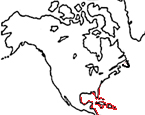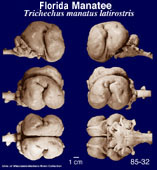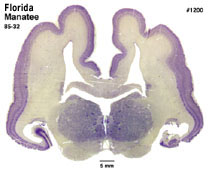|
Florida
Manatee
(Trichechus manatus latirostris) #85-32 |
||||
|
|
Physical
characteristics and distribution
|
|
Florida
Manatee Trichechus manatus latirostris They
are herbivorous, but often ingest small invertebrates which
may provide an important source of protein. In captivity, T.
manatus latirostris has been known to consume up to one
fourth its body weight per day in wet greens. This manatee is
primarily a solitary and nomadic animal traveling established
routes over hundreds of kilometers. The channels used are usually
2 meters or more in depth and the manatees like to swim at a
depth of 1-3 meters. Speeds average between 3-7 km/hr, but 25
km/hr may be obtained when necessary. |
|
Description
of the brain
|
|
The brain of the Florida Manatee is about the size of a softball. The surface of the cerebral cortex is relatively unconvoluted when compared with other mammals of similar size (cow, zebra, seal). |
|
Animal
source and preparation
|
|
All
specimens collected followed the same preparation
and histological procedure.
|
Other
Related Resources (websites and publications)
List of Specimens | Explore Collections | Brain Sections | Brain Evolution | Brain Development | Brain Circuitry | Brain Functions | Location and Use | Related Web Sites | Contact Us | Search MSU Database | Personnel | Home



